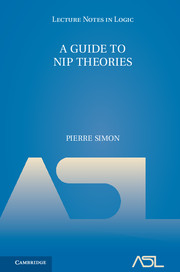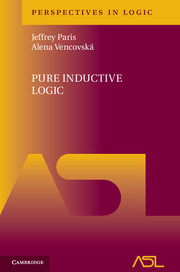Refine search
Actions for selected content:
5849 results in Programming Languages and Applied Logic
Frontmatter
-
- Book:
- Building High Integrity Applications with SPARK
- Published online:
- 05 October 2015
- Print publication:
- 31 August 2015, pp i-iv
-
- Chapter
- Export citation
2 - The Basic Spark Language
-
- Book:
- Building High Integrity Applications with SPARK
- Published online:
- 05 October 2015
- Print publication:
- 31 August 2015, pp 18-67
-
- Chapter
- Export citation
INDEX
-
- Book:
- A Guide to NIP Theories
- Published online:
- 05 July 2015
- Print publication:
- 16 July 2015, pp 155-156
-
- Chapter
- Export citation
APPENDIX A - EXAMPLES OF NIP STRUCTURES
-
- Book:
- A Guide to NIP Theories
- Published online:
- 05 July 2015
- Print publication:
- 16 July 2015, pp 133-144
-
- Chapter
- Export citation
APPENDIX B - PROBABILITY THEORY
-
- Book:
- A Guide to NIP Theories
- Published online:
- 05 July 2015
- Print publication:
- 16 July 2015, pp 145-146
-
- Chapter
- Export citation
CHAPTER 2 - THE NIP PROPERTY AND INVARIANT TYPES
-
- Book:
- A Guide to NIP Theories
- Published online:
- 05 July 2015
- Print publication:
- 16 July 2015, pp 7-30
-
- Chapter
- Export citation
REFERENCES
-
- Book:
- A Guide to NIP Theories
- Published online:
- 05 July 2015
- Print publication:
- 16 July 2015, pp 147-154
-
- Chapter
- Export citation
CHAPTER 5 - FORKING
-
- Book:
- A Guide to NIP Theories
- Published online:
- 05 July 2015
- Print publication:
- 16 July 2015, pp 57-72
-
- Chapter
- Export citation
CHAPTER 7 - MEASURES
-
- Book:
- A Guide to NIP Theories
- Published online:
- 05 July 2015
- Print publication:
- 16 July 2015, pp 85-100
-
- Chapter
- Export citation
CHAPTER 9 - DISTALITY
-
- Book:
- A Guide to NIP Theories
- Published online:
- 05 July 2015
- Print publication:
- 16 July 2015, pp 121-132
-
- Chapter
- Export citation
CHAPTER 8 - DEFINABLY AMENABLE GROUPS
-
- Book:
- A Guide to NIP Theories
- Published online:
- 05 July 2015
- Print publication:
- 16 July 2015, pp 101-120
-
- Chapter
- Export citation
CHAPTER 6 - FINITE COMBINATORICS
-
- Book:
- A Guide to NIP Theories
- Published online:
- 05 July 2015
- Print publication:
- 16 July 2015, pp 73-84
-
- Chapter
- Export citation
CHAPTER 3 - HONEST DEFINITIONS AND APPLICATIONS
-
- Book:
- A Guide to NIP Theories
- Published online:
- 05 July 2015
- Print publication:
- 16 July 2015, pp 31-42
-
- Chapter
- Export citation
CHAPTER 1 - INTRODUCTION
-
- Book:
- A Guide to NIP Theories
- Published online:
- 05 July 2015
- Print publication:
- 16 July 2015, pp 1-6
-
- Chapter
- Export citation
CHAPTER 4 - STRONG DEPENDENCE AND DP-RANKS
-
- Book:
- A Guide to NIP Theories
- Published online:
- 05 July 2015
- Print publication:
- 16 July 2015, pp 43-56
-
- Chapter
- Export citation
Contents
-
- Book:
- A Guide to NIP Theories
- Published online:
- 05 July 2015
- Print publication:
- 16 July 2015, pp v-viii
-
- Chapter
- Export citation
Frontmatter
-
- Book:
- A Guide to NIP Theories
- Published online:
- 05 July 2015
- Print publication:
- 16 July 2015, pp i-iv
-
- Chapter
- Export citation

A Guide to NIP Theories
-
- Published online:
- 05 July 2015
- Print publication:
- 16 July 2015

Pure Inductive Logic
-
- Published online:
- 05 May 2015
- Print publication:
- 02 April 2015
BIBLIOGRAPHY
-
- Book:
- Pure Inductive Logic
- Published online:
- 05 May 2015
- Print publication:
- 02 April 2015, pp 327-336
-
- Chapter
- Export citation
